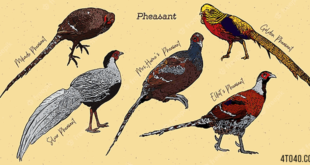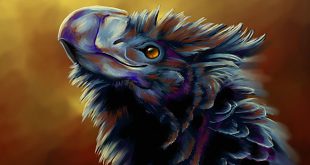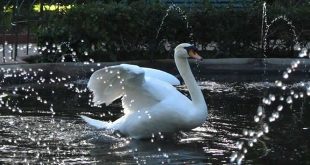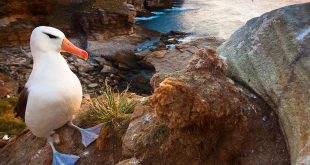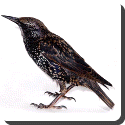 Starling — Starlings are small to medium-sized passerine birds in the family Sturnidae. The name “Sturnidae” comes from the Latin word for starling, sturnus. Many Asian species, particularly the larger ones, are called mynas, and many African species are known as glossy starlings because of their iridescent plumage. Starlings occur naturally in the Old World, from Europe, Asia and Africa, to northern Australia and the islands of the tropical Pacific. Several European and Asian species have been introduced to these areas as well as North America, Hawaii and New Zealand, where they generally compete for habitat with native birds and are considered to be invasive species. The starling species familiar to most people in Europe and North America is the European Starling, and throughout much of Asia and the Pacific the Common Myna is indeed common.
Starling — Starlings are small to medium-sized passerine birds in the family Sturnidae. The name “Sturnidae” comes from the Latin word for starling, sturnus. Many Asian species, particularly the larger ones, are called mynas, and many African species are known as glossy starlings because of their iridescent plumage. Starlings occur naturally in the Old World, from Europe, Asia and Africa, to northern Australia and the islands of the tropical Pacific. Several European and Asian species have been introduced to these areas as well as North America, Hawaii and New Zealand, where they generally compete for habitat with native birds and are considered to be invasive species. The starling species familiar to most people in Europe and North America is the European Starling, and throughout much of Asia and the Pacific the Common Myna is indeed common.
Starlings have strong feet, their flight is strong and direct, and they are very gregarious. Their preferred habitat is fairly open country, and they eat insects and fruit. Several species live around human habitation, and are effectively omnivores. Many species search for prey such as grubs by “open-bill probing”, that is, forcefully opening the bill after inserting it into a crevice, thus expanding the hole and exposing the prey; this behavior is referred to by the German verb zirkeln.
Plumage of many species is typically dark with a metallic sheen. Most species nest in holes, laying blue or white eggs.
Starlings have diverse and complex vocalizations, and have been known to embed sounds from their surroundings into their own calls, including car alarms, and human speech patterns. The birds can recognize particular individuals by their calls, and are currently the subject of research into the evolution of human language.
The starlings are medium sized passerines. The shortest-bodied species is Kenrick’s Starling (Poeoptera kenricki), at 15 centimetres (6 in), but the lightest-weight species is Abbott’s Starling (Poeoptera femoralis), at 34 grams (1.2 oz). The largest starlings are the mynas of the genus Mino, especially the Yellow-faced (Mino dumontii) and Long-tailed Mynas (Mino kreffti). These mynas can exceed 30 centimetres (1 ft) and weigh over 225 grams (8 oz). Several species of starling exhibit sexual dimorphism in size.
There is less sexual dimorphism in plumage however, with only 25 species showing such differences between the sexes. The plumage of the starlings is often brightly coloured due to iridescence; this colour is derived from the structure of the feathers, not from any pigment. Some species of Asian starling have crests or erectile feathers on the crest. Other ornamentation includes elongated tail feathers and brightly coloured bare areas on the face. These colours can be derived from pigments, or, as in the Bali Starling, structural colour, caused by light scattering off parallel collagen fibres. The irises of many species are red and yellow, although those of younger birds are much darker.
The starlings are generally a highly social family. Most species associate in flocks of varying sizes throughout the year. A flock of starlings is called a murmuration. These flocks may include other species of starlings and sometimes species from other families. This sociality is particularly evident in the their roosting behaviour; in the non-breeding season some roosts can number in the thousands of birds.
Starlings imitate a variety of avian species and have a repertoire of about 15-20 distinct imitations. They also imitate a few sounds other than those of wild birds. The calls of abundant species, calls that are simple in frequency structure and calls that show little amplitude modulation are preferentially imitated. There are local dialects of mimicked sounds. Starlings have also been known to imitate objects, such as phone boxes and cars.
The diets of the starlings are usually dominated by fruits and insects. Many species are important dispersers of seeds in Asia and Africa, for example white sandlewood, Indian Banyan. In addition to trees they are also important dispersers of parasitic mistletoes. In South Africa the Red-winged Starling is an important disperser of the introduced Acacia cyclops. Starlings have been observed feeding on fermenting over-ripe fruit, which led to the speculation that they might become intoxicated by the alcohol. Laboratory experiments on European Starlings have found that they have disposal enzymes that allow them to break down alcohol very quickly. In addition to consuming fruits, many starlings will also consume nectar. The extent to which starlings are important pollinators is unknown, but at least some are, such as the Slender-billed Starling of alpine East Africa, which pollinates giant lobelias.
 Kids Portal For Parents India Kids Network
Kids Portal For Parents India Kids Network
